Menu

Did you know that farm-direct sales make up less than 1% of all farm gate sales? Despite this, some farms have found success through direct marketing. This shows the big potential and the careful balance needed in direct farm sales.
I’ve looked into many case studies across the United States about successful direct farm sales. From 2002 to 2005, places like Idaho, Oregon, and Washington were studied. They uncovered key insights into how farmers could effectively market their produce directly.
Let’s look at Greentree Naturals in Sandpoint, Idaho. They operate on 12 organic acres. They sell all their products directly through farmers’ markets, CSAs, and to retail outlets, restaurants, and caterers. Another example is M&M Heath Farms in Buhl, Idaho. They run a 450-acre farm, with much being certified as organic. They also focus on direct marketing.
S&S Homestead on Lopez Island, Washington intrigues us too. They’ve been free of debt for 35 years. They make money with CSA and by directly selling custom butchered animals. Fields Farm in Bend, Oregon, is known for its organic ideals. They sell directly on the farm, in markets, through CSA, and to retail shops.
These studies provide great lessons for both new and experienced farmers. They offer models of success in a changing market. By selling directly to people, farms build strong communities, show innovation, and use technology well.
In today’s world, direct farm sales are crucial for farms and the country economy. They cut out the middleman, giving farmers a better deal. This also helps form strong bonds with those buying their produce. To be successful, farmers need to understand the best ways to sell and price their goods. Prices might differ, like being higher for restaurants and lower for schools and shops.
More and more people want fresh, local, and eco-friendly food, boosting direct farm sales. This method allows smaller farmers to sell to consumers directly. It’s all about finding your niche, like offering special delivery or organic products. Studies show what works when selling straight from the farm and the best ways to set prices.
Direct farm sales have greatly changed over time, keeping up with what people want to buy. While the number of farms selling directly dipped in 1992, a 59% increase by 2007 showed this way of selling was on the rise again. Now, we know that selling directly helps farms make more money, regardless of their size. It also creates jobs in rural areas and is good for the planet.
Looking at successes in other countries helps us learn more. In Korea, for example, a co-operative managed to give 76% of the final sale back to the farmer. This model proves how important direct sales are for farmers’ incomes and rural economies.
The Davis Farmer’s Market stands out as a leading example in direct marketing. It is supported by various organizations like the Fund for Rural America and USDA. Together with the UC Sustainable Agriculture Research & Education Program and Agricultural Sustainability Institute at the University of California, Davis, it showcases how community-based agricultural marketing works well.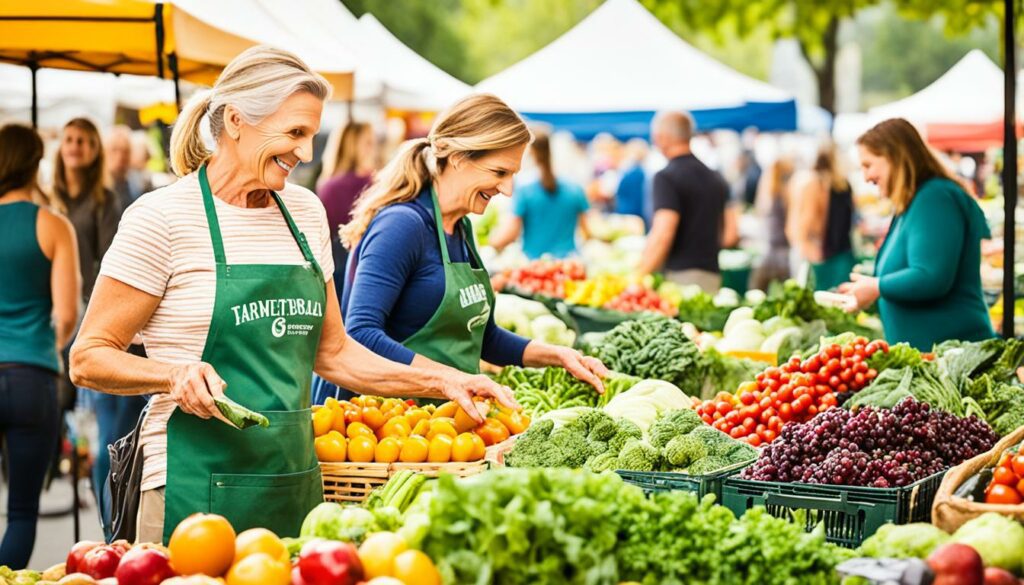
The Davis Farmer’s Market is great at linking local farms with people in the area. The Sacramento area sees around 14% of its farms selling directly to customers. This is more than the national rate of 9%. This shows the market’s impact on supporting local farming and strengthening the farm-consumer link. Yolo County’s farms make a solid $66,568 each year by selling directly to their community. This proves how beneficial community-focused marketing is.
The market uses several strategies that are worth examining for farm-to-table sales. Sacramento region’s farms make about $19,518 every year through direct sales. This shows the financial potential of connecting with customers directly. Products sold directly also bring in seven times the price than when sold through other routes.
Handling food miles well is one of their important approaches. Even though the distance travelled by food might not always mean it’s less fuel-efficient, the market focuses on efficient truck loads. This helps save fuel. They also keep their marketing costs low through smart promotion tactics. These include newsletters and good signs.
Direct farm sales are making a big difference, even in places with lower incomes, like Placer County. For example, they earn about $6,924 a year through direct marketing. Also, direct marketing is gaining ground in schools, with up to 42% of them buying locally. In Vermont, around 5.6% of food purchases were local. This contributed a significant $1.4 million to Vermont’s economy.
| Region | Direct Marketing Income | Average Income Increase | School Program Impact |
|---|---|---|---|
| Sacramento | $19,518 | – | 42% of schools |
| Yolo County | $66,568 | – | – |
| Placer County | $6,924 | – | – |
| Vermont | – | – | $1.4 million |
This look at the Davis Farmer’s Market proves its importance in direct marketing. By outlining its strategies and successes, it offers guidance for other areas wishing to do the same.
Technology has changed how farmers sell directly to people. It offers many tools for farmers. Now, they can improve their work and talk directly to buyers. This change is happening fast because of things like climate change and people moving around. These digital tools make farming easier and more productive, like the Internet of Things and machine learning.
Important technologies boost direct farm sales. Things like Big Data and cloud computing give farmers new insights. But, some worry about who owns the data and if it’s safe. Even so, big companies and startups are putting money into agriculture technology.
Using tech in farming can be very good. In the Dominican Republic, a tech program helped rice farmers a lot. This program improved their work and how much money they made. But, the prices they got for their crops didn’t go up much.
Good connections, like LPWAN and 5G, are key for better farming. These could add a lot of money to the world’s economy by 2030. This is important as more people need food. In 2050, we’ll need 70% more food. So, farming must get better and more connected.
Using digital tools is great for selling farm products. With new tech, farmers can do better, reach more people, and sell more efficiently.
Brookfield Farm is a great example of farm success through direct sales and working together. Ailbhe Gerrard’s study for Nuffield Ireland talks about how this works in Ireland. It shows how farms can earn more, provide jobs, and help the environment using these methods.
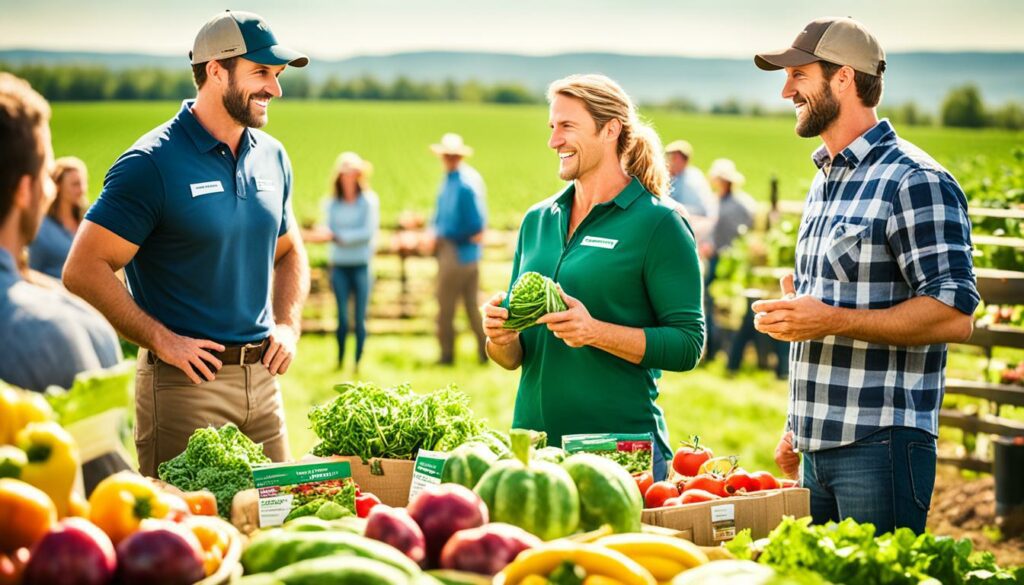
Brookfield Farm has become diverse. They sell not only honey but also wool, appealing to local lovers of handmade goods. This shows that farms can make more money by offering different products. They have also switched to organic and eco-friendly farming, which helps the planet.
Brookfield Farm works together with others, boosting their business and support from the community. This way of working together is good for farmers. It lets them sell their products directly and supports local people. It also means they can share the costs and profits, making their income more stable.
Brookfield Farm’s story teaches important things. It shows how careful planning is vital for financial success. Keeping track of everything can make a farm run better. They also highlight the value of working with the local community. This is key to their lasting popularity. As Paul J. Meyer said, doing things well isn’t by chance but through hard work and a clear plan.
| Strategic Area | Implementation | Outcome |
|---|---|---|
| Diversification | Value-added products, Agritourism | Increased income streams |
| Co-operative Model | Collaborative marketing, Shared resources | Enhanced market reach, Reduced financial risk |
| Financial Planning | Farm Finance Challenge, Crop Planning | Improved efficiency, Sustainability |
| Community Engagement | Direct consumer interactions | Sustained consumer support, Market stability |
Brookfield Farm’s story, among others, shows how a mix of strategies and working together can create a strong farm business. With careful planning and involvement with the community, farms can do more. This leads to a more stable and successful future for farmers.
Direct farm sales have changed farming, letting farmers connect directly with buyers. This includes selling online or by mail and at farmers’ markets. Each way opens new opportunities for farmers.
Fields Farm in Bend, Oregon, uses the internet to sell more than just what’s at their farm. They also sell through CSA projects. Meanwhile, Honeyacre Produce Company, known for hydroponics, sells online and in stores now.
With online sales, an organic farm made over $144,000, creating jobs and income. These sales show big potential for farms to grow through the internet.
Gretree Naturals in Sandpoint, Idaho, sells all its produce directly, at markets and through CSAs. This ensures fresh food for buyers and a stable income for the farm.
Case Study #1 shows that markets are key, making up most income at 71%. This farm earned over $81,000, proving these markets are still very important.
M&M Heath Farms in Idaho is also very diverse in its direct sales. It sells fresh food at markets, and also to restaurants and caterers. By using many strategies, the farm is doing well.
These examples of direct farm sales show both high tech and traditional ways can work. They share important lessons and show how farmers can adapt and succeed.
Studying direct farm sales from different parts of the world teaches us a lot. We look at successful strategies used in Japan, Israel, and the Netherlands. These methods show that farmers want to sell straight to people. It helps their incomes and the planet.
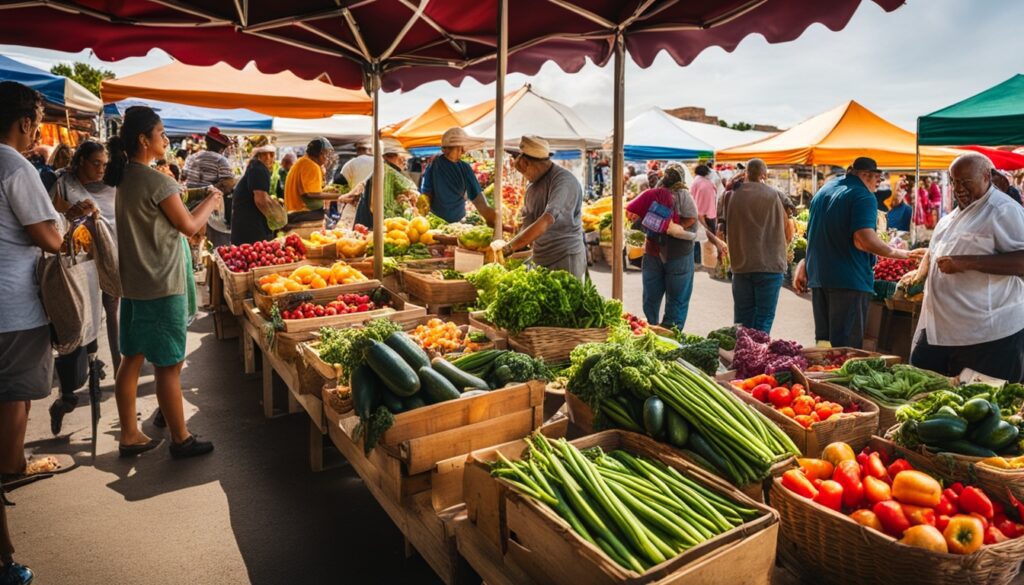
Japan’s local chains tell people exactly where and who made their food. They sell in diverse places like markets and hospital stands, reaching more buyers. In Israel, good processing and moving food around support local farms well. The Netherlands talks about strong, trusting links with their sellers. This helps everything run smoother and on time.
Ireland can learn a lot from these examples. Farmers in Ireland should focus on sharing product info and selling in different places. This helps reach more people. Building or using good move products better and faster. It’s also crucial to have strong ties with others in the supply chain. This makes sure people get fresh, local food without fail.
Direct farm sales boost the economy for many farms. By selling directly, farmers make more money and have steady sales. We will look at some stories that show how this works.
Farmers who sell their produce directly earn more. For example, in Case Study #1, an organic farm made 71% of its money from markets. They also got 15% from CSA and 14% from wholesalers. This mix made them $81,945 in total, with $14,557 for labour and $26,160 added.
In Case Study #2, farm-to-table sales brought in 46% of the farm’s income. And sales to restaurants made up 29%. This diversity led to income of $220,861, two extra jobs, and $65,861 for worker pay. Case Study #3 is another example, making 79% of its income from selling produce. This pushed the farm’s value to $144,875 and created $75,738 for labour, plus a new job.
Farmers see less income uncertainty with direct sales. Case Study #1 mixed revenue from markets with CSA. This made their money steady, even with just 0.3 new jobs.
Case Study #2 focused 60% of their spending on workers. This, combined with income from direct sales, helped them stay strong. Lastly, Case Study #3 balanced spending on seeds and labour. This made their money sources stable.
| Case Study | Total Output | Jobs Created | Labour Income | Value Added |
|---|---|---|---|---|
| Case Study #1 | $81,945 | 0.3 | $14,557 | $26,160 |
| Case Study #2 | $220,861 | 2 | $65,861 | $85,683 |
| Case Study #3 | $144,875 | 1 | $75,738 | $91,731 |
Looking into sustainability, I’ve found that selling directly from farms helps the environment a lot. This is shown by many studies into agricultural marketing. Farmers who sell directly often use ways of farming that help the land and protect wildlife.
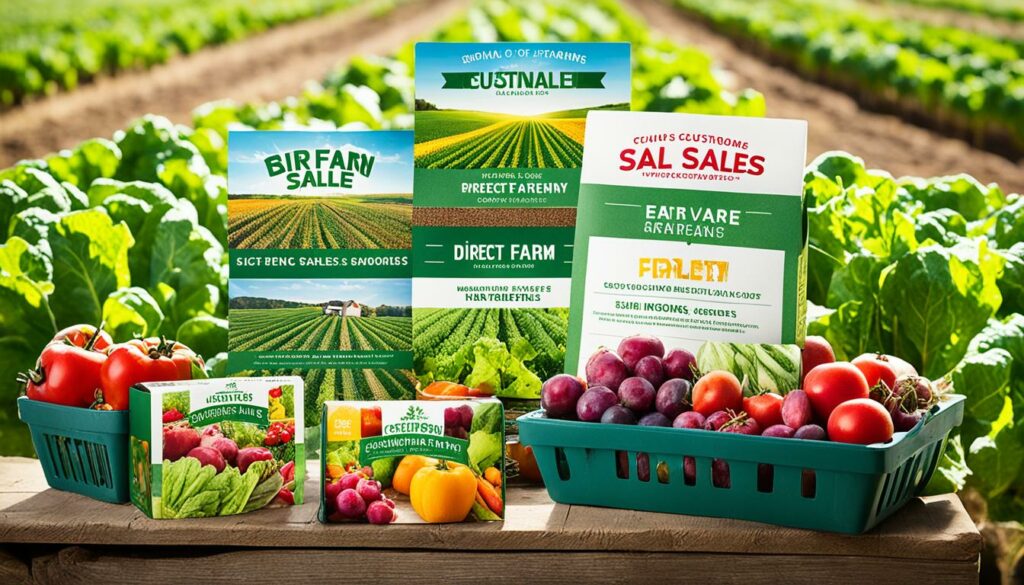
When farmers sell straight to people, they can farm in ways that boost nature. They grow different crops and mix in animals. This makes the land healthier, stops too many pests, and keeps the soil good.
Farmers markets are a big part of this good work. Their number has grown a lot over the years. They now help a lot of farmers sell their food in a way that looks after the earth. Most of these markets are run to help the planet, too.
More and more, shoppers want products that don’t harm the environment. Research from 2015 showed that farmers markets were a big deal in this. They made up nearly a quarter of all farmer’s sales direct to the people. All this added up to $711 million. It’s clear; people like to buy things that are kind to the planet.
Also, some farmers markets are open all year. This shows that the desire for fresh and eco-friendly food is always there.
“San Francisco’s amendment to its city code in 2009 to require farmers markets to accept food assistance, including SNAP benefits via EBT, underscores the intersection of sustainability and social responsibility. This policy ensures a broader customer base has access to fresh, sustainable food.” – USDA
All these parts point to a bright future for farming that looks after nature. When people join in by buying straight from the farm, they not only get fresh food. They also help the land around them stay healthy.
| Year | Farmers Markets | Revenue ($millions) | Nonprofit Registration |
|---|---|---|---|
| 1994 | 1,755 | – | – |
| 2015 | 8,476 | 711 | – |
| 2019 | 8,761 | – | 65% |
To sum up, selling food directly from farms not only makes economic sense. It also does a lot of good for our planet and helps us all live more sustainably.
Community Supported Agriculture (CSA) models connect farmers and consumers directly. They build trust, share responsibility, and empower the community. This way, farms can earn money and people get to be a part of farming.
In 2015, U.S. farms quickly sold $8.7 billion of food locally. About a third of this went straight to consumers, showing the power of CSAs. A study from Colorado showed that farms might make less money with CSAs, but they build strong communities. This happens because people come together to support access to healthy food and learn about nutrition.
Four vegetable farms in New York found that CSAs were best for their business. A mix of selling methods worked well, but CSAs stood out. Such a method helps farmers make a steady income.
Interviews with CSA farmers in Western Massachusetts also highlighted some key points. While CSAs might not be the most profitable, they offer big personal and community rewards. They help new farmers get land, which is vital for the future of farming.
Research from detailed analyses of three organic farms indicated that while marketing costs per dollar of revenue were highest in farmers’ markets, they were lowest in wholesale channels, highlighting a strategic balance needed for successful CSA and direct marketing models.
Even though CSA farms face tough competition, they offer something special. This includes both making money and building strong communities. With more than 6,000 CSAs in the U.S., their growth and integration are key for future farm success.
Direct farm sales are great, but they come with their own set of problems. Farmers face big challenges, from getting their foot in the door to dealing with changing customer needs. This makes it crucial for them to plan well and be ready to adjust, just like some smart farmers have shown in their stories.
Starting out with direct sales, farmers often find it hard to reach stable markets. Shockingly, less than 1% of farm gate sales come from direct farm sales. To get ahead, they need sharp plans to find the right markets. Yet, many have found their place by telling great stories about their goods, or by joining farmers’ markets and CSA efforts. These ways can be key, with a good portion of sales coming from them.
In a revealing note from the USDA, we learn that only 7% of organic sales were direct in 2008. This shows the mountain that organic farmers need to climb. But, it also points to a chance for growth through smart marketing and more consumer education.
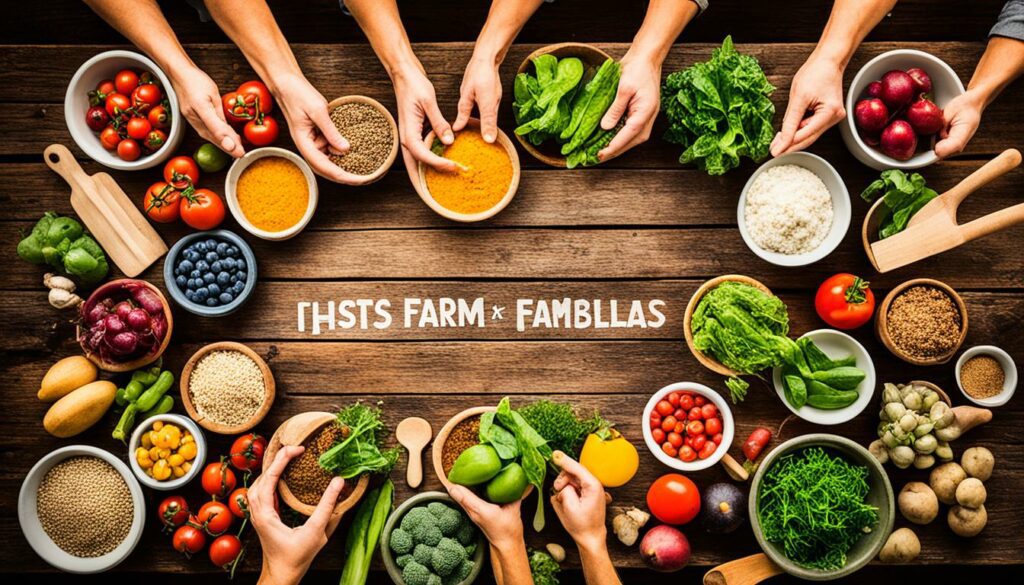
Juggling between production and what the market wants is tough. Direct sales markets grew by 59% between 1997 and 2007. But keeping up is a challenge, as each farm sells on average $8,000 direct a year. There’s a big gap in sizes and their market reach.
Newcomers to farming, about 25% in 2012, showed mixed results in direct sales. Some 18% made over $50,000 in 2017, proving that face-to-face selling works. However, it clearly needs skillful handling. These new farmers rely heavily on direct markets for their sales.
Dealing with the work and getting it where it needs to go also pose problems. About 67% of those new to farming find the seasonal nature of produce tricky, and 52% say moving their product is hard. But, with wisdom and time, these things get easier, as shown by the more experienced farmers.
| Statistics | Data |
|---|---|
| Farm-direct sales share of all farm gate sales | Less than 1% |
| Growth in direct market sales (1997 to 2007) | 59% |
| Farm-direct sales amount (2007) | $1.211 billion |
| Percentage of organic sales through direct markets (USDA 2008) | 7% |
| Average direct sales per farm annually | $8,000 |
| Beginning farmers using direct-to-consumer markets | 88% |
| Percentage of beginning farmers with sales over $50,000 (2017) | 18% |
Starting a farm can seem hard without proper help. For those new to farming, getting into direct sales requires specific steps for success. Knowing what consumers like is key. It shapes how you market and what you offer.
Choosing the right way to sell directly is important. It should fit what your farm does and who you sell to. Consider selling through U-pick, farm stands, and more. If you sell meat, check out Meat Suite. It helps you sell in bulk, reaching more customers. Good marketing is often more important than what you produce. Also, getting the right insurance can help protect your business.
Following health and safety rules is a must. The Farmers Market Federation of New York helps direct sellers meet these rules. They offer help and training. This keeps your food safe for customers.
Knowing what customers want is key to selling directly. Joining the National Farm to School Network links farms with schools. This boosts farm reputation and helps children eat healthier. Supporting these kinds of groups builds trust with customers. It’s also important to handle food properly to keep it good for sale.
Cornell Agricultural Marketing experts have great tips on how to sell and what customers like. They have newsletters from 1988 to 2010. This info is vital for new farmers. Knowing the market helps you pick the best ways to sell, whether that’s online, through the mail, or in person.
Case studies show farm stands and U-pick sales are at about 35%. Farmer’s markets and CSA farms are at 28% and 15%. This shows there are many ways to succeed in direct sales.
| Sales Model | Sales Percentage |
|---|---|
| Farm Stands & U-pick | 35% |
| Farmer’s Markets | 28% |
| CSA Farms | 15% |
The way farms sell their produce is changing fast. It’s vital for farmers to keep up with current trends. This helps them stay ahead and sell more. With new tech and knowing what consumers want, farm sales can improve a lot.
New technologies are changing how farms sell directly to us. Things like online markets and smart farm tools make it all easier. This means even farmers in remote areas can sell to people far away. Tech also helps use resources better, making farms more productive and sustainable.
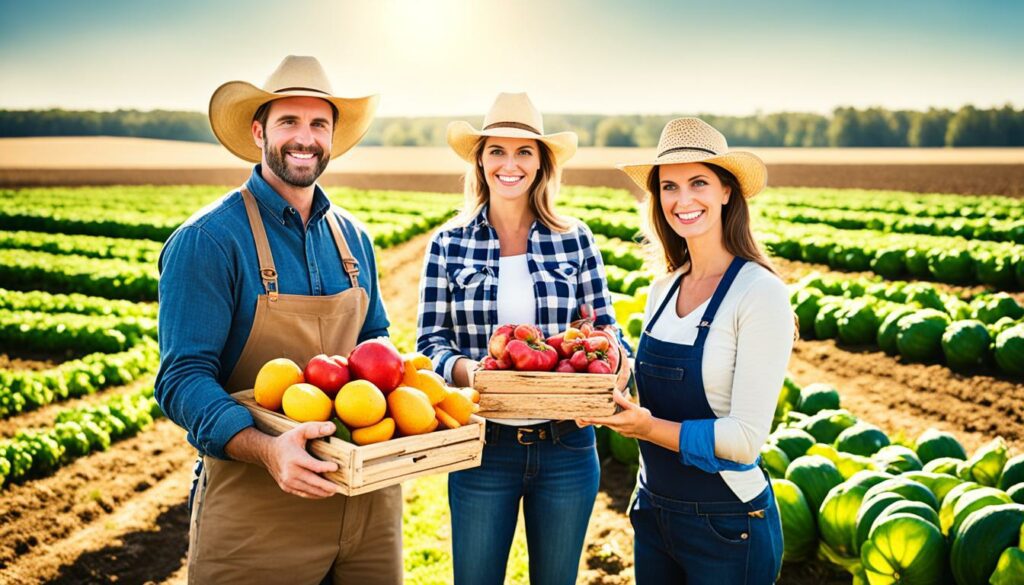
Changes in what consumers want also matter. More people are choosing food that’s local and sustainable. This is a big chance for farms to win over loyal customers. Also, people care a lot more about health and the environment now. Farms focusing on fresh and organic food have a great advantage.
Back in 2012, only a tiny bit of farm sales came directly from farmers. But, this has been changing. More farms are selling their products right to us. Since 2008, the number of these farms has grown by 6%. Their sales have also gone up by 8%. This shows there’s big potential in selling directly to people.
| Farm Sales Bracket | Percentage of Total Farms | Total Sales (Million USD) | Percentage of Total Sales |
|---|---|---|---|
| $1-$499 | 26% | $7.8 | 1% |
| $500-$999 | 14% | $13.7 | 1% |
| $1,000-$4,999 | 36% | $121.8 | 9% |
| $5,000-$9,999 | 10% | $97.3 | 7% |
| $10,000-$24,999 | 8% | $164.8 | 13% |
| $25,000-$49,999 | 3% | $143.7 | 11% |
| $50,000 or more | 3% | $760.8 | 58% |
Knowing about new tech and what customers want can help farmers a lot. Being updated and flexible is key to success in the farm business.
The Ishida Lamb Farm is a great example of how farms can change and grow. It shows that with new ideas, farming can be very successful. This helps farmers make more money and gives jobs in the countryside.
Ishida Lamb Farm’s success comes from trying new things. They moved from just raising lambs to adding new activities. This change means they earn money in different ways, not just from selling lambs.
Several important things have helped Ishida Lamb Farm do well:
Their success fits with Japan’s growing cities and changing countryside. As places like Maebashi City grew, farming evolved too. This led to new ways of farming and more people wanting farm products. This shows how different changes can lead to farming success.
| Factors | Ishida Lamb Farm |
|---|---|
| Diversification | Expanded into catering, online sales, and retail |
| Community Engagement | Active in local farmers’ markets |
| Sustainability | Adopted eco-friendly methods |
In conclusion, we looked at various direct farm sales case studies. They show the big use in selling straight to customers, cutting out the usual go-betweens. We saw how places like Singapore, Indonesia, and many more use new tech to reach customers better.
Direct farm sales offer more than just making more money or new jobs in the countryside. They create deep links between those who grow the food and the ones who eat it. By using new tech and different ways to sell—like via internet or cooperatives—they can change and grow easily.
And, selling directly is what more people want now: food grown in ways that help the planet last longer. By being clear and green, farms get closer to their customers. This not only makes people happier about their food but also helps the environment a lot.
So, here’s what the experts suggest: share what works with others, fix the holes in the market, help out with money, and teach new people how to start farms. These steps can make farming and food-selling stronger for everyone. Direct farm sales become key for a better farm future this way.
The Davis Farmer’s Market and Brookfield Farm are great examples of direct selling success. They use strategies like community-supported agriculture and high-tech farming. These methods have helped them thrive.
Direct sales are crucial for a farm’s financial health and for boosting rural areas. They also strengthen the link between producers and consumers.
Direct sales have changed a lot over the years. They went from simple markets to selling online. This evolution is to meet modern needs and economic changes.
Technology has made farm sales more efficient and visible. It has opened up new markets through online sales and other digital tools. These changes have helped farms grow.
Brookfield Farm’s success comes from offering more than crops. They also sell products directly and work closely with consumers. This strategy has given them stability and jobs.
Models range from selling online to setting up market stalls. These methods help farms reach various customers, each with their own tastes.
Studies in Japan, Israel, and the Netherlands have shown effective direct sales. They offer lessons for other places too. This shows that these strategies can work worldwide.
By selling directly, farmers can earn more and avoid fluctuating incomes. They don’t rely on middlemen, which makes their earnings more stable.
Direct sales support farming practices that are good for the environment and promote biodiversity. More and more, consumers want farming that’s kind to the earth.
CSA brings farmers and communities closer. It involves local people in farming, making them partners in the process. This encourages a sense of collective care for the land.
Setbacks include getting access to markets, managing growth, and maintaining environmental health. But, the best farmers find ways to tackle these challenges and succeed.
Starting well means knowing what customers want, keeping an eye on trends, and being ready to change. This is how new farmers can do well in direct sales.
New technology and changing markets are expected to continue. They’ll affect how farmers sell directly, making the scene more dynamic. This prepares farms for a future of growth.
Ishida Lamb Farm found success by adding catering and retail to their operations. This has helped them create a sustainable and profitable business model.